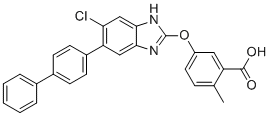
MK-3903
CAS No. 1219737-12-8
MK-3903( MK3903 )
Catalog No. M10828 CAS No. 1219737-12-8
MK-3903 is a potent and selective, direct and oral AMPK activator with EC50 of 9 nM.
Purity : >98% (HPLC)
 COA
COA
 Datasheet
Datasheet
 HNMR
HNMR
 HPLC
HPLC
 MSDS
MSDS
 Handing Instructions
Handing Instructions
| Size | Price / USD | Stock | Quantity |
| 2MG | 48 | In Stock |


|
| 5MG | 87 | In Stock |


|
| 10MG | 160 | In Stock |


|
| 25MG | 296 | In Stock |


|
| 50MG | 478 | In Stock |


|
| 100MG | 691 | In Stock |


|
| 500MG | 1422 | In Stock |


|
| 1G | Get Quote | In Stock |


|
Biological Information
-
Product NameMK-3903
-
NoteResearch use only, not for human use.
-
Brief DescriptionMK-3903 is a potent and selective, direct and oral AMPK activator with EC50 of 9 nM.
-
DescriptionMK-3903 is a potent and selective, direct and oral AMPK activator with EC50 of 9 nM; activates 10 of the 12 phosphorylated AMPK (pAMPK) complexes with EC50s of 8-40 nM, improves lipid metabolism and insulin sensitization in mice.
-
In VitroMK-3903 (compound 42) is a potent and selective AMP-activated protein kinase (AMPK) activator with an EC50 of 8 nM. MK-3903 activates 10 of the 12 phosphorylated AMPK (pAMPK) complexes with EC50 values in the range of 8 to 40 nM and maximal activation >50%. MK-3903 partially activates pAMPK5 (36% max) and it does not activate pAMPK6. MK-3903 demonstrates low permeability (Papp=6×10-6 cm/s) in LLC-PK1 cells42 and is a substrate of human liver uptake transporters OATP1B1 and OATP1B3 (organic anion transporter proteins). Results show that MK-3903 binds moderately to the prostanoid DP2 (CRTH2) receptor (binding IC50=1.8 μM) but not in the presence of 10% human serum (binding IC50>86 μM).
-
In VivoThe pharmacokinetics of MK-3903 (compound 42) in C57BL/6 mice, Sprague to Dawley rats, and beagle dogs are characterized by moderate systemic plasma clearance (5.0 to13 mL/min/kg), a volume of distribution at steady state of 0.6 to 1.1 L/kg, and a terminal halflife of ~2h. Acute oral administration of MK-3903 (3, 10, and 30 mg/kg) to high-fructose fed db/+ mice results in significant inhibition of hepatic fatty acid synthesis (FAS) for all three doses.
-
SynonymsMK3903
-
PathwayMembrane Transporter/Ion Channel
-
TargetAMPK
-
RecptorAMPK
-
Research Area——
-
Indication——
Chemical Information
-
CAS Number1219737-12-8
-
Formula Weight454.91
-
Molecular FormulaC27H19ClN2O3
-
Purity>98% (HPLC)
-
SolubilityDMSO: 70 mg/mL; Water: Insoluble; Ethanol: Insoluble ( < 1 mg/ml refers to the product slightly soluble or insoluble )
-
SMILESCC1=C(C=C(C=C1)OC2=NC3=C(N2)C=C(C(=C3)C4=CC=C(C=C4)C5=CC=CC=C5)Cl)C(=O)O
-
Chemical Name5-[(5-[1,1'-Biphenyl]-4-yl-6-chloro-1H-benzimidazol-2-yl)oxy]-2-methylbenzoic acid
Shipping & Storage Information
-
Storage(-20℃)
-
ShippingWith Ice Pack
-
Stability≥ 2 years
Reference
1. Lan P, et al. J Med Chem. 2017 Nov 9;60(21):9040-9052.
molnova catalog



related products
-
PF-06885249
PF-06885249 (PF06885249) is a potent, direct AMPK activator with EC50 of 7.0 and 27 nM for α1β1γ1 and α2β1γ1, respectively.
-
Gomisin J
Gomisin J is a natural product and have vasodilatory activity.?Gomisin J suppresses lipid accumulation by regulating the expression of lipogenic and lipolytic enzymes and inflammatory molecules through activation of AMPK, LKB1 and Ca2+/calmodulin-dependent protein kinase II and inhibition of fetuin-A in HepG2 cells.
-
ZLN-024
A novel AMPK allosteric activator that has no effect on mitochondrial function or the ADP/ATP ratio; directly activate recombinant AMPK α1β1γ1 and its homologue α2β1γ1 with EC50 of 0.42 uM and 0.95 uM, respectively.



 Cart
Cart
 sales@molnova.com
sales@molnova.com


